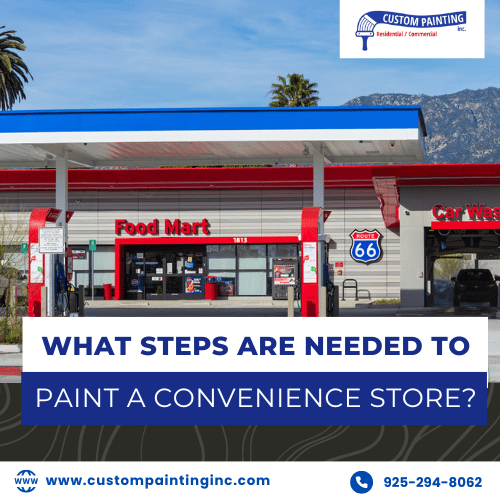Maintaining a convenience store’s appearance is crucial for business success in the Concord, CA area. A well-kept store attracts customers, instills confidence, and enhances the shopping experience.
If you own or run a convenience store, keep the word “convenience” in mind. Clean and bright interiors can create a pleasant and comfortable shopping experience for your customers. A well-maintained and appealing storefront can help you attract more shoppers. Regular maintenance is indeed necessary to keep your convenience store business afloat.
Overview of benefits of a fresh coat of paint
- Attracting customers – A freshly painted store is more visually appealing, drawing in more foot traffic and making a positive first impression.
- Maintaining a lean and professional look – Regular painting keeps the store looking clean, organized, and polished, which can boost customer satisfaction and loyalty.
- Protecting the building –Paint acts as a protective barrier against weather elements, preventing damage and prolonging the life of the building.
Planning and preparation

Assess your Vallejo area convenience store’s physical condition, choose the correct materials and colors, get the necessary tools and supplies, and schedule work efficiently (especially if you want to keep the store open). Following these steps ensures a smooth and successful painting project that enhances the store’s appearance and longevity.
Assessing the store
Inspecting the current condition of the interior and exterior walls
- Inspect interior and exterior walls thoroughly for cracks, peeling paint, mold, or water damage.
- Take note of any structural repairs needed, such as fixing holes, repairing drywall, or addressing any moisture issues.
Identifying areas needing repair or special attention
- Identify areas that require special preparation, such as heavy cleaning, sanding, or priming.
- Pay attention to high-traffic areas. They might need more durable paint or additional protective coatings.
- Be sure to check to see if existing commercial stenciling needs to be updated.
Choosing colors and materials
Considering brand colors and themes
- Select colors that align with the store’s branding and create a welcoming atmosphere for customers.
- Consider combining primary brand colors and complementary shades to enhance the store’s visual appeal.
Selecting high-quality and durable paint suitable for commercial use
- Choose commercial-grade paint that can withstand heavy use and frequent cleaning.
- Consider options with added benefits like anti-microbial properties or easy-clean finishes for hygiene and maintenance.
Deciding on finishes
- Decide on the appropriate finishes for different areas of the store. For instance:
- Matte is great for hiding imperfections. However, it is less durable and more challenging to clean.
- Gloss is a highly durable and easy-to-clean paint finish. It is ideal for high-traffic areas but can highlight wall imperfections.
- Semi-gloss finishes balance matte and gloss, providing durability and cleaning ease with a moderate sheen.
Gathering supplies
- Compile a comprehensive list of supplies needed for the project:
- Paint (in chosen colors and finishes)
- Brushes and rollers of various sizes
- Painter’s tape to protect edges and trim
- Drop cloths to cover floors and furniture
- Ladders for reaching high areas
- Safety equipment like masks, gloves, and goggles
Scheduling the work
Planning the painting schedule to minimize disruption to business operations
- Develop a schedule that allows the store to remain operational as much as possible, perhaps painting during off-hours or days with the lowest customer traffic.
- Consider breaking the project into phases to avoid complete shutdowns.
Considering weather conditions for exterior painting
- Plan exterior painting during favorable weather conditions to ensure proper paint adhesion and drying.
- Avoid painting in extreme temperatures, high humidity, or rainy conditions.
Pre-painting preparations
Proper preparation helps you achieve a professional and long-lasting paint job. Cleaning, sanding, filling, priming, and protecting non-painting areas can ensure a high-quality finish that enhances your Walnut Creek convenience store’s appearance.
Cleaning and surface preparation
1. Cleaning the walls
- Thoroughly clean the walls to remove dirt, grease, and debris. Doing so ensures the paint adheres well and results in a smooth finish.
- Use a mild detergent solution for general cleaning and a degreaser for particularly greasy areas.
2. Sanding and filling
- Sand any rough areas on the walls to create a smooth surface for painting.
- Fill in any cracks, holes, or imperfections with appropriate filler material. Once dry, sand these areas to ensure they become flush with the surrounding surface.
3. Applying primer
- Depending on the condition of the walls and the type of paint you’ll use, a primer may be necessary. Primer helps the paint adhere better and can provide a more uniform finish. This factor is true when covering dark or uneven surfaces.
Protecting non-painting areas
1. Using painter’s tape
- Apply painter’s tape to protect edges, trim, and other areas you don’t want painted. Ensure the tape is applied straight and pressed down firmly to prevent paint from seeping under.
2. Covering floors, shelves, and merchandise
- Use drop cloths or plastic sheets to cover floors, shelves, and immovable merchandise. Doing so helps protect these areas from paint splatters and drips.
- Secure the coverings to prevent them from shifting during the painting process.
Painting process
By following these guidelines, you can achieve a professional-looking paint job that enhances the appearance and durability of a Pleasant Hill area convenience store, both inside and out.
Interior painting
- Techniques for cutting In and rolling large areas
-
-
- Cutting in – Use a high-quality angled brush to paint the edges where walls meet the ceiling, floor, and around windows and doors. Start by dipping the brush into the paint, removing excess paint, and then applying a steady hand to create a smooth edge.
- Rolling – Use a roller for large wall areas. Load the roller with paint, roll off the excess, and apply in a “W” or “M” pattern to distribute the paint evenly before filling in the gaps. This method helps to avoid lap marks and ensures a uniform coat.
-
- Tips for achieving an even coat and avoiding streaks or drips
-
- Always use high-quality paint and tools.
- Apply thin coats of paint and allow sufficient drying time between applications.
- Keep a wet edge to prevent lap marks.
- Feather out edges by lightly rolling over them.
Exterior painting
- Considerations for weather and drying times
-
-
- Choose days with mild, dry weather for exterior painting. Don’t paint in direct sunlight or when you’re expecting rainfall.
- Pay attention to temperature and humidity levels. These factors can affect drying times and paint adhesion.
-
- Techniques for painting different surfaces
-
-
- Brick – Clean the surface thoroughly, apply a masonry primer, and use a thick-nap roller or a brush designed for rough surfaces.
- Metal – Remove the rust, apply a rust-inhibiting primer, and use paint specifically formulated for metal surfaces.
- Wood – Sand the surface, apply a wood primer, and use exterior-grade paint. For best results, follow the wood grain.
-
- Safety precautions when using ladders or scaffolding
-
- Always ensure ladders and scaffolding are stable and on level ground.
- Use safety harnesses and fall protection gear when working at heights.
- Follow manufacturer guidelines for ladder and scaffolding use.
Special considerations
- Dealing with high-traffic areas and maintaining accessibility
-
-
- Schedule painting during off-hours or in sections to minimize disruption.
- Use fast-drying paints to reduce downtime.
- Mark clear “wet paint” areas and ensure safe paths for customers and staff.
-
- Painting around signage and windows
-
- Use painter’s tape to protect window frames and signage edges.
- Consider removing small signages and fixtures to avoid paint splatters.
- Carefully cut in around these areas with a brush to ensure clean lines and avoid overlapping paint.
Post-painting steps
Cleaning up
Proper disposal of paint and cleaning supplies:
- Dispose of any leftover paint according to local regulations, often at designated hazardous waste disposal sites.
- Clean brushes, rollers, and other painting tools with the appropriate solvent (water for latex paint, mineral spirits for oil-based paint) and allow them to dry before storing or discarding them.
Removing painter’s tape and drop cloths:
- Carefully remove the painter’s tape while the paint is still slightly tacky to avoid peeling off any dried paint.
- Fold and remove drop cloths, being cautious not to spread any paint that may have dripped onto them.
Final touches
Inspecting for touch-ups or missed spots:
- Conduct a thorough inspection of the painted surfaces, looking for any areas that need additional coverage or touch-ups.
- Use a small brush to fix any missed spots or imperfections.
Reassembling shelves, displays, and merchandise:
- Once the paint is fully dry, carefully move shelves, displays, and other fixtures back into place.
- Reorganize merchandise on the shelves and ensure everything is in order before reopening the store.
Ventilation and drying
Ensuring proper ventilation to aid in drying and odor removal:
- Open windows and doors to allow fresh air to circulate through the space, which helps to speed up drying and remove paint fumes.
- Use fans or air purifiers to enhance airflow and odor removal.
Recommended drying times before reopening the store:
- Follow the manufacturer’s guidelines for drying times, typically allowing at least 24 hours for the paint to dry to the touch.
- Ensure that the paint is fully cured (which can take up to a few weeks) before heavy use to avoid damage to the new paint job.
Maintenance and longevity
By following these tips, you can maintain the appearance and integrity of your convenience store’s paint job, ensuring it remains attractive and inviting to customers for years.
Regular cleaning and touch-ups
- Regular cleaning – Clean the exterior walls periodically to remove dirt, grime, and pollutants. Use a soft brush or sponge and mild detergent to avoid damaging the painted surface.
- Addressing minor damage – Inspect the paint job regularly for chips, cracks, or peeling. Promptly address these minor issues by sanding the affected area and applying a matching touch-up paint to prevent further deterioration.
- Protective coatings – Consider applying a clear, protective sealant over the paint. It can provide additional resistance against weathering, UV rays, and pollution, extending the paint job’s life.
Future repainting
- Signs it’s time for a repaint – Look for signs such as fading, chalking, bubbling, or extensive cracking. These indicate that the paint is deteriorating, and a new coat may be necessary.
- Planning for repainting – Keep a detailed record of the type of paint used, the color code, and the date of the last painting. This information will be crucial when planning a future repaint to ensure consistency.
- Maintenance schedule – Establish a maintenance schedule that includes regular inspections and cleaning. Also, create a timeline for potential repainting. Depending on environmental factors and the quality of the original paint job, commercial buildings may need to be repainted every 5-7 years.
Conclusion
Painting plays a crucial role in enhancing the appearance of a Lafayette, CA area store and significantly contributes to customer satisfaction. A well-painted store helps attract more customers and creates a pleasant shopping environment that encourages them to return. One cannot overstate the impact of a refreshed and appealing look on your store’s success cannot.
If you own or run a convenience store, you should undertake this project to revitalize its appearance. Investing in a professional paint job can transform your space, making it more inviting and vibrant, ultimately driving better business results.
Don’t hesitate to take the next step. Call Custom Painting, Inc. at 925-686-0903 and message here today to discuss your options. Start your journey towards a more attractive and customer-friendly store.




